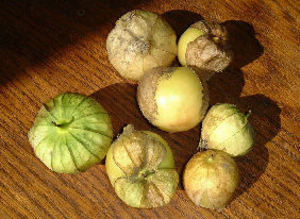With Spring just around the corner, it will soon be time to start thinking about putting in your garden. This year add something new and different and plant the tomatillo plant, a distant relative of regular tomatoes. This plant looks like a normal tomato plant and is grown just like the tomato, but the resemblance ends there. Instead of a large globe of red or yellow fruit, the tomatillo is a small, round, husk-covered fruit and is approximately one-half to three quarters of an inch in diameter.
The tomatillo is a relatively new plant for gardens in the United States. It is an annual, growing on an upright leafy (and sometimes woody) bush in the nightshade family. Extensively grown in Mexico and Guatemala and in the southern most part of California, it is used in many dishes commonly known as Mexican or Latino cuisine. It can be used to make sauce, salsa, stews, soups, and as a flavoring for rice. It can be fried or made into a dessert sauce, jam, or marmalade. It can also be eaten raw right off the bush.
Seedlings should be started approximately six weeks before the last frost is anticipated and planted one-eighth of an inch deep. After six weeks, the plants should be hardened off by taken them outside for a week during the day and then planted when the ground has warmed up. Plants should be 18-24 inches apart with rows 3-4 feet apart. They also need a lot of sun, so do not select an area that receives too much shade from trees. They require a lot of water, so mulching around the plants is a good idea to help hold moisture in the ground. It will grow in any soil suitable for tomatoes but not in soaking wet situations. Fertilizer containing nitrogen and phosphorus can be added as a dressing around the plant.
The tomatillo, sometimes called ground cherry or husk tomato, grows approximately 3-4 feet tall. The plant should be staked or in a tomato cage to keep the fruit off the ground to reduce spoilage of the fruit. The growing season is between 70 and 90 days, depending on the variety of seeds purchased and they can be green, yellow, or purple in color. The fruit is ripe when the husk turns brown and begins to split. Once picked, the husks should be removed and the fruit will last up to two weeks refrigerated and it can also be frozen. Individual plants may produce between 60 to 200 fruits or about two pounds per plant in a season
Some people like to use the tomatillo as an ornamental plant as I did at first; however, if used ornamentally, the fruit should still be picked. Use a large planter and make sure the plant gets enough water. It is a good idea to use two or three plants in order for the tomatillo to make the fruit as cross-pollination is needed.
For those who would like to try the tomatillo without growing it, it can be purchased in many stores or found canned in ethnic food sections and the fruit can be used in any recipe.
Sources:
Tomatillo, husk-tomato
What is a Tomatillo?
Mexican Husk Tomato


